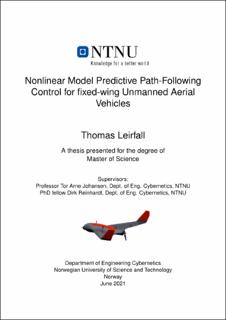Nonlinear Model Predictive Path-Following Control for fixed-wing Unmanned Aerial Vehicles
Master thesis

Permanent lenke
https://hdl.handle.net/11250/2786140Utgivelsesdato
2021Metadata
Vis full innførselSamlinger
Sammendrag
Denne masteroppgaven studerer path problemet. Path problem refererer til å styre et kjøretøy og deretter holde det nær en forhåndsdefinert geometrisk kurve i et Euclidean space. I motsetning til trajectory tracking er posisjonen langs banen en grad av frihet slik at størrelsen på hastighetsvektoren i de fleste tilfeller kontrolleres frihetsgrad. NMPC kan brukes til å følge geometrisk utfordrende kurver, og samtidig utføre optimalt med hensyn til brukerdefinert kostnadsfunksjon og begrensninger.
Denne oppgaven bygger på fordypnings prosjektet[1] som utforsket et path problem med to forskjellige tilnærminger. Den første var en vektorfeltbasert path following algoritme for å kontrollere kurs og høyde i en successive loop closure. Og en NMPC med en forenklet kinematisk modell. Den kinematiske modellen vil bli videreutviklet i denne oppgaven og inkludere en lav nivå autopilot i indre sløyfen. Det vil også være en komplett dynamisk modell av UAV X8 Skywalker i NMPC.
Vil utforsket to måter å parameterisere path, men en rett linje og en buet i det Euclidean space. Videre vil det være en simuleringsstudie og sammenligne den forenklede kinematiske og dynamiske modell i en NMPC med en geometriske kontrollere VFB for rett linje og NDGPFG for den buede banen.
En simulering av resultatene kan sees på https://www.youtube.com/watch?v=SYCMKUfa-mk This master’s thesis studies the path following problem. The path-following problem refersto steering a vehicle and then keeping it close to a predefined geometric curve in the Euclidean space. In contrast to trajectory tracking, the position along the path is a degree of freedom such that the magnitude of the velocity vector is in most cases controlled independently. Nonlinear model predictive controller (NMPC) can be used to follow geometrically challenging curves, and at the same time performing optimally with respect to user-defined cost function and constraints.
This thesis builds on the specialization project[1] which explored a straight-line path problemwith two different approaches. The first was a vector field-based path-following algorithmfor controlling the course and height in a successive loop closure. And an NMPC with asimplified kinematic model. The kinematic model will be further developed in this thesis andinclude a low-level autopilot in the inner-loop. There will also be a complete dynamic modelof the unmanned aerial vehicle (UAV) X8 Skywalker in the NMPC.
Will explored two ways to parameterize the path where the path is a straight line and a curvedpath in the Euclidean space R3. Further, there will be a simulation study and comparing thesimplified kinematic and dynamic model NMPC to geometric controlers vector field-based(VFB) for straight-line path and nonlinear differential geometric path-following (NDGPFG) forthe curved path.
A simulation of the results are seen at https://www.youtube.com/watch?v=SYCMKUfa-mk.